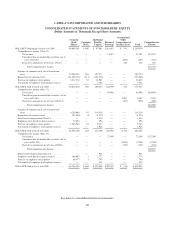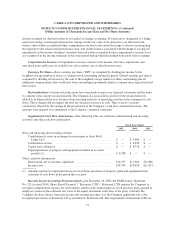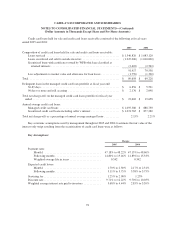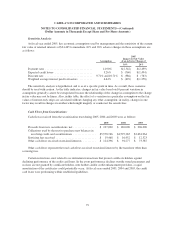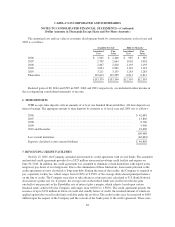Cabela's 2005 Annual Report Download - page 85
Download and view the complete annual report
Please find page 85 of the 2005 Cabela's annual report below. You can navigate through the pages in the report by either clicking on the pages listed below, or by using the keyword search tool below to find specific information within the annual report.CABELA’S INCORPORATED AND SUBSIDIARIES
NOTES TO CONSOLIDATED FINANCIAL STATEMENTS—(Continued)
(Dollar Amounts in Thousands Except Share and Per Share Amounts)
certain locations or to maintain office facilities in certain locations. For these types of grants, the Company
records the grants as a component of deferred grant income, and recognizes them as the milestones associated
with the grant are met. As of the fiscal years ended 2005 and 2004, the Company was in compliance with all
material requirements.
Credit Card Reward Program—Every Cabela’s Club VISA cardholder receives Cabela’s points based on
the dollar amount transacted on WFB’s credit card. Cabela’s points can be redeemed at any Cabela’s store or
through a Cabela’s catalog or Internet purchase. Classic or Gold cards are issued. Classic Cardholders receive 1%
in points for every dollar spent and 2% in points for purchases at Cabela’s. Gold Cardholders receive 1% in
points for every dollar spent and 3% in points for purchases at Cabela’s. There is no limit or expiration on points
that can be earned by a cardholder. Points are accrued and expensed as the cardholder earns them. The expense is
shown as a reduction of Financial Services revenue. The amount of unredeemed credit card points was $47,938
and $38,552 as of the fiscal years ended 2005 and 2004, respectively. In addition to credit card points, vouchers
are issued to card members at Club events and to new members when they apply for card membership. These
vouchers are used to purchase Cabela’s merchandise. All of these items are part of the customer rewards
program. The amount of credit card rewards expensed as an offset to Financial Services revenue was $62,723,
$52,939 and $39,876 in 2005, 2004 and 2003, respectively.
Income Taxes—The Company files consolidated federal and state income tax returns with its wholly-owned
subsidiaries. The consolidated group follows a policy of requiring each entity to provide for income taxes in an
amount equal to the income taxes that would have been incurred if each were filing separately. The Company’s
tax year-end is the Saturday closest to September 30.
Deferred income taxes are computed using the liability method under which deferred income taxes are
provided on the temporary differences between the tax bases of assets and liabilities and their financial reported
amounts.
Use of Estimates—The preparation of financial statements in conformity with accounting principles
generally accepted in the United States of America requires management to make estimates and assumptions that
affect the reported amounts of assets and liabilities and disclosure of contingent assets and liabilities at the date
of the financial statements and the reported amounts of revenue and expenses during the reporting period. Actual
results could differ from those estimates.
Stock-Based Compensation—The Company follows Accounting Principles Board (“APB”) Opinion
No. 25, Accounting for Stock Issued to Employees and related interpretations. The Company has adopted the
disclosure-only provisions of Statement No. 123, Accounting for Stock-Based Compensation, as amended by
Statement No. 148, Accounting for Stock-Based Compensation—Transition and Disclosure. Under Statement
No. 123, the fair value of stock option awards to employees is calculated through the use of option pricing
models, even though such models were developed to estimate the fair value of freely tradable, fully transferable
options without vesting restrictions, which differ from the Company’s stock option awards. These models also
require subjective assumptions, including future stock price volatility and expected time to exercise, which affect
the calculated values. The Company’s calculations are based on a single option valuation approach and
forfeitures are recognized as they occur. Stock-based compensation costs are reflected in net income where the
options granted under those plans had an exercise price that is less than the fair value of the underlying common
stock on the date of grant. As of January 1, 2006 the Company adopted Statement 123(R), Share Based Payment
as discussed in “Recently Issued Accounting Pronouncements.”
73





